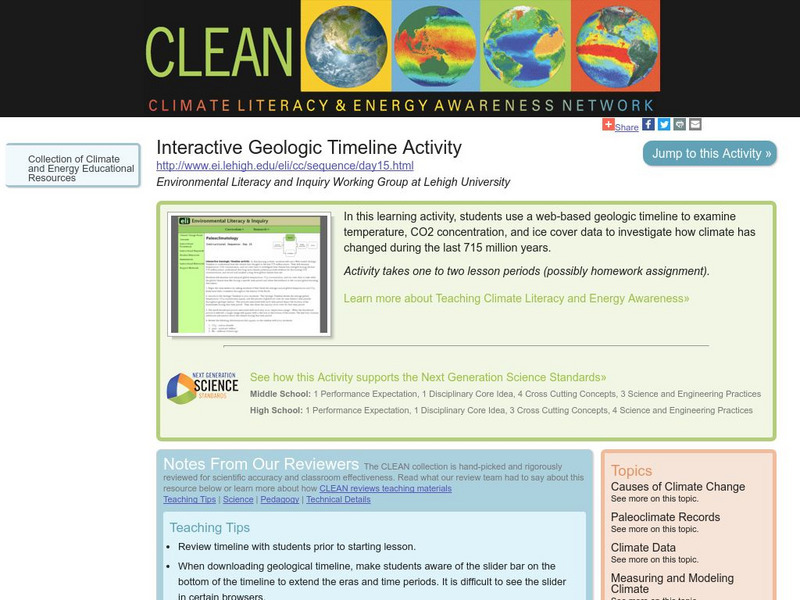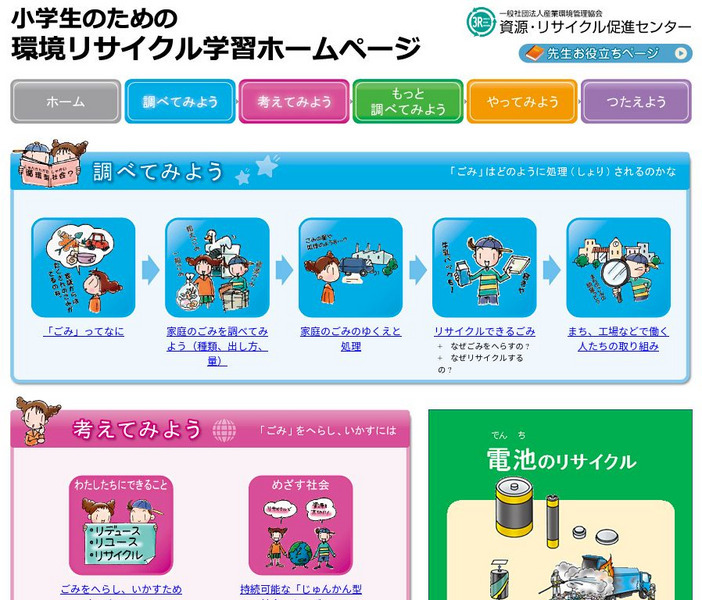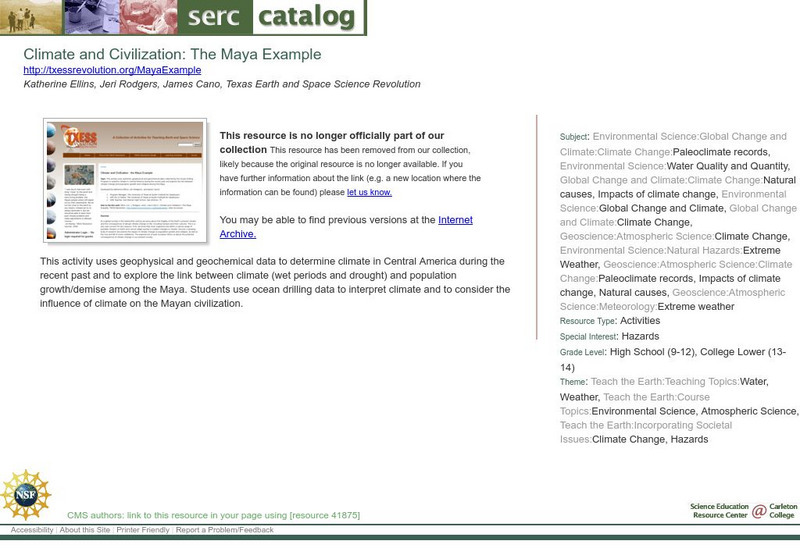Climate Literacy
Clean: Mauna Loa Co2 Collection Data
This data-intensive activity uses real world datasets to cover topics such as weather v. climate, air circulation around the globe, seasonal effects, and climate change.
Climate Literacy
Clean: Carbon Footprint
In this lesson students investigate how much greenhouse gas (carbon dioxide and methane) their family releases into the atmosphere each year and relate it to climate change. To address this, students use the Environmental Protection...
Climate Literacy
Clean: Interactive Geologic Timeline Activity
In this learning activity, young scholars use a web-based geologic timeline to examine temperature, CO2 concentration, and ice cover data to investigate how climate has changed during the last 715 million years. Students will gain an...
Climate Literacy
Clean: Carbon Calculator Activity
In this learning activity, students use a web-based carbon calculator to determine their carbon footprint on the basis of their personal and household habits and choices. Students identify which personal activities and household choices...
Climate Literacy
Clean: Understanding Ocean Acidification
The following is a series of 5 activities regarding ocean acidifcation Young scholars will learn about rising Carbon Dioxide in the atmosphere, climate change, ocean reefs, marine calcifers and ocean pH.
Climate Literacy
Clean: It's Time to Tell the Story About Buds, Leaves and Global Warming
In this activity, students explore how, in New England, the timing of color change and leaf drop of deciduous trees is changing.
Climate Literacy
Clean: Introduction to Earth's Climate
This lesson is an introduction to Earth's climate and covers key principles regarding Earth's unique climate, atmosphere, and regional and temporal climate differences. Students will gain an understanding of how the weather and climate...
Climate Literacy
Clean: A Global Issue: The Impacts of Climate Change
This is lesson five of a 9-lesson module. Activity explores the effects of climate change on different parts of the Earth system and on human well-being: polar regions, coral reefs, disease vectors, extreme weather, and biodiversity.
Science Education Resource Center at Carleton College
Serc: A Reader's Guide to Climate Change
In this activity from the Deep Earth Academy, students divide into groups to read and discuss one of nine short articles (1-2 pages) about research done by the Ocean Drilling Program. These articles discuss our understanding about past...
Science Education Resource Center at Carleton College
Serc: Carbon Temperature Model
With this carbon/temperature interactive model, young scholars investigate the role of atmospheric carbon in the greenhouse effect using a relationship between atmospheric carbon dioxide and global temperature.
US Environmental Protection Agency
Epa: Global Warming Wheel Card [Pdf]
Students construct a Global Warming Wheel Card, a hand-held tool that they can use to estimate their household's emissions of carbon dioxide and learn how they can reduce them.
Other
Clean Japan Center: Recycling
Japanese content for elementary students. Helps younger children explore environmental issues. Topics include recyling, ozone destruction, global warming, and stewardship of natural resources. Good illustrations. Also includes reading...
Other
University of East Anglia: Climatic Research Unit
This is a site from a university page of the University of East Anglia that is focused on climatic research. It offers links to information sheets, research areas, publications, and other climate links. Each of the information sheets...
Other
Alberta Environment: Focus on Climate Change [Pdf]
This article explains what climate change is, what causes it, why it poses such a threat and some of the things we can do to combat it.
Other
Personal Website: Richard Treves: Lesson Plans
Study climate change with Google Earth, explore glaciers in the Himalayas, and learn how to avoid lava destroying a home in Hawaii with these three expert-developed lesson plans.
Other
Libcom: Climate, Class, and the Neolithic Revolution
This is the first in a series of articles about food under global warming. This article takes a long view of the relationship between climate, agriculture, and class society.
Open Curriculum
Open Curriculum: Earth Day Network: Healthy Earth, Sick Earth [Pdf]
Madeline Kaplan's book, Planet Earth Gets Well, introduces a instructional activity focused on climate change. Young scholars will discover ways to keep Earth healthy.
US Geological Survey
Lake Pontchartrain Basin Foundation: The Forces Are With Us: Natural Forces
A collection of science activities that focus on natural forces that affect Lake Pontchartrain Basin. Students will understand how global climate change relates to storm events, subsidence, and erosion. Background information on...
Society for Science and the Public
Science News for Students: Antarctica Warms, Which Threatens Penguins
Describes the threat of climate change in the Antarctica to emperor penguins by affecting the ice sheets where penguin breeding grounds are located.
Climate Literacy
Clean: Climate and Civilization: The Maya Example
Students use geophysical and geochemical data collected by the Ocean Drilling Program to examine climate in Central America during the recent past. They also have the opportunity to investigate the link between climate change and...
Science Education Resource Center at Carleton College
Serc: Global Warming Graph Analysis
Learners interpret a variety of graphs from Intergovernmental Panel on Climate Change reports learning the details of climate change.
PBS
Pbs: Global Warming
This site provides an in-depth exploration from PBS into the international issue of global warming. Find out why scientists believe the global climate is changing, and explore actions certain governments have taken to prevent this...
Other
Environmental Defense Fund: Tips to Fight Global Warming
Read and take action to fight global warming with these 6 tips, complete with links and other climate change resources.
University Corporation for Atmospheric Research
Ucar: Dendrochronology Trees: Recorders of Climate Change
Young scholars discover how tree age can be determined by studying the rings, and how ring thickness can be used to deduce times of optimal growing conditions. Then they investigate simulated tree rings applying the scientific method to...










![Epa: Global Warming Wheel Card [Pdf] Activity Epa: Global Warming Wheel Card [Pdf] Activity](https://content.lessonplanet.com/knovation/original/84558-16fbabe6543bc08a2c6e61c7cc193c00.jpg?1661812588)


![Alberta Environment: Focus on Climate Change [Pdf] Website Alberta Environment: Focus on Climate Change [Pdf] Website](https://static.lp.lexp.cloud/images/attachment_defaults/resource/large/FPO-knovation.png)





